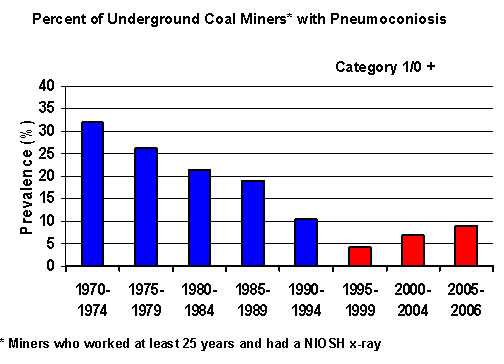Application of the ILO International Classification of Radiographs of Pneumoconioses to Digital Chest Radiographic Images
July 2008
DHHS (NIOSH) Publication Number 2008-139

Go back to Workshop Index page.
A NIOSH Scientific Workshop
The following content has been adapted from a presentation given at the NIOSH Scientific Workshop: Application of the ILO International Classification of Radiographs of Pneumoconioses to Digital Chest Radiographic Images.
DISCLAIMER: The findings and conclusions in these proceedings are those of the authors and do not necessarily represent the official position of the National Institute for Occupational Safety and Health (NIOSH). Mention of any company or product does not constitute endorsement by NIOSH. In addition, citations to Web sites external to NIOSH do not constitute NIOSH endorsement of the sponsoring organizations or their programs or products. Furthermore, NIOSH is not responsible for the content of these Web sites.
The NIOSH Perspective
Edward L. Petsonk, MD
Senior Medical Officer
Division of Respiratory Disease Studies
March 12, 2008
THIS IS AN IMPORTANT ISSUE.WE SINCERELY APPRECIATE YOUR TAKING THE TIME TO HELP.
The ILO Classification - Background
- "A means for describing and recording systematically the radiographic abnormalities in the chest provoked by the inhalation of dusts."
- International Conference on Silicosis, Johannesburg, 1930
- Modifications/revisions 1950, 1959, 1970, 1980, 2002
- "Used internationally for epidemiological research, for screening and surveillance of those in dusty occupations, and for clinical purposes. May lead to better international comparability of data concerning the pneumoconioses."
- Object: “to codify radiographic abnormalities of the pneumoconioses in a simple, reproducible manner. Does not define pathological entities nor take into account working capacity. Does not imply legal definitions of pneumoconioses for compensation purposes.”
The Challenge: ILO Classification of Digital Chest Radiographs
Why is there a need?


The Challenge: ILO Classification of Digital Chest Radiographs
- Why is there a need?
- Digital imaging market penetration
- Soon majority of facilities exclusively digital
The Challenge: ILO Classificationof Digital Chest Radiographs
- How to assure detailed and uniform images for classification?
- Multiple hardware systems (DR, CR)
- Software versions, compression algorithms
- File formats, compatibilities
- Display terminal: resolution, perception, image manipulation
- Display of ILO Standard Radiograph images
- How best to merge science and practicality?
- Adequate specification of procedures, software, and file formats
- Objective evidence for equivalence with traditional approach
- Commercially available systems (evolving technology)
The NIOSH Perspective
- Health Surveillance Programs
- Epidemiological and Clinical Research
- Compensation and Clinical Evaluations
- Coal Workers
- OSHA Regulations
- Private Industry
- Federal Benefits
- State Workers Compensation
- Tort Liability
- International Labor Organization
- National Institutes of Health
The outcome must be defensible – There will be someone who will not like it!
The NIOSH Perspective
- A science-based but practical specification for the acquisition and formation of digital chest radiographic images
- Assure uniformity and integrity of digital images used for classification
- Methods, equipment, procedures, and conditions that lead to images equivalent to traditional chest radiographs for reliably demonstrating the absence, presence, and extent of dust-related pulmonary abnormalities
- Procedures and criteria to approve facilities
- Practical and reliable performance criteria to assure continuing image quality
The NIOSH Perspective
- A science-based but practical specification for the classification of digital radiographs using the ILO system
- Procedures, image processing, display hardware, file formats and storage, including software options
- Comparison images (i.e., ILO standard radiograph images) for classification of digital images
- Image manipulations permissible during classification
The NIOSH Perspective
- Local and disseminated systems for managing digital chest images
- Interoperability
- Data formats, file management
- Software and hardware compatibility
- Secure image transfers from x-ray facilities and to readers
- Assure confidentiality, reliable file identification
- Durable data archives
- Interoperability
The NIOSH Perspective
- Capacity to examine and approve B Readers using digital chest radiographic images
- Remote examination
- Preservation of the integrity of the process
- Equivalence of digital B reader examination with previous hard copy examination
- Selection of digital examination images
- Quality assurance and/or calibration functions
The NIOSH Perspective
- The integration of digital images into occupational practice must be done now.
- It requires the best information available and support from numerous partners.
- Thank you for agreeing to contributing your time, knowledge, and experience!
- Page last reviewed: June 6, 2014
- Page last updated: June 6, 2014
- Content source:
- National Institute for Occupational Safety and Health Education and Information Division


 ShareCompartir
ShareCompartir